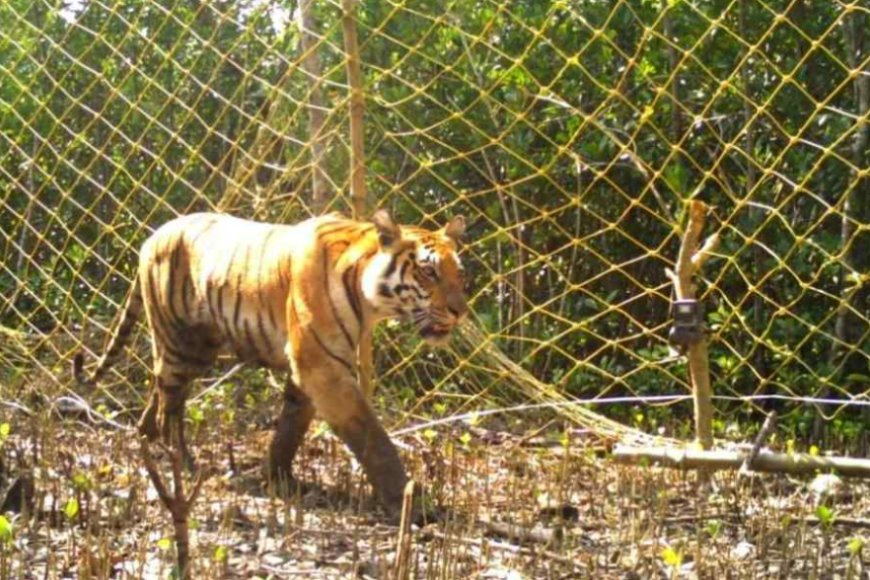Except for the headline, this story has not been edited by Press Time staff and has been published from a syndicated feed.
Camera Traps Capture Tigers in Previously Undetected Pockets, Raising Concerns About Expansion and Carrying Capacity

Foresters in the Sunderbans have reported that an increase in the tiger population is forcing the big cats onto more recent land.
Two such pockets, according to one of them, are Dhanchi, a small forest island on the eastern side of G-Plot beach on the edge of the Bay of Bengal, and Thakuran Char, a section of land formed by the periodic accretion of soil on the banks of the Thakuran river.
An adult male tiger has already been discovered by trap cameras in Dhanchi. We have pugmarks in Thakuran Char. There were no tigers known to exist in these two pockets. Trap cameras will be installed in both pockets as part of the ongoing annual (state-level) tiger census for official documentation, according to Milan Mandal, the South-24 Parganas division's divisional forest officer.
In the Sunderbans, the number of tigers has been gradually increasing. Tigers are relocating to more recent areas as a result. The Sunderbans have a different tiger density than any other tiger habitat due to its difficult terrain. Here, a tiger can be found in about 25 sq km. About 35 square kilometers make up Dhanchi, and about 100 square kilometers make up the island on the Thakuran bank, according to Mandal.
There are three tiger ranges in the South-24 Parganas division: Matla is the third range; Dhanchi and the Thakuran char are located in Ramganga and Raidighi, respectively.
Status of Tigers: Co-Predators and Prey in India, 2022, the report from the last quadrennial national tiger census, was released in 2023. The Wildlife Institute of India (WII) and the National Tiger Conservation Authority (NTCA) collaborated to prepare the report, which estimated the number of tigers in the Sunderbans at 101.
According to the report, the density of tigers in the Indian portion of the Sunderbans was estimated to be 4.27 per 100 square kilometers. According to the report, the mangrove forest has an estimated carrying capacity of 4.68 tigers per 100 square kilometers.
In 2010, when 70 tigers were counted during the Sunderbans tiger census, trap cameras were first used. In 2014, there were 76, and by 2018, there were 88.
Around Christmas Eve, the tiger that had been tracked through the Dhanchi Forest crossed the river and arrived at the boundaries of a few villages on the other side. It was driven back into the forest on December 27.
The first picture was taken in the second week of November inside the Dhanchi Forest. The larger Dhulibhasani forest, a known tiger habitat in the Ramganga range, is thought to be the big cat's new home.
The NTCA and the WII have received the photos taken at Dhanchi Forest for additional examination.
Every tiger has different markings. According to officials, the images of the Dhanchi tiger should match the Sunderbans tigers currently listed in the database. After the tiger has been identified, foresters will know with certainty where it originated.
According to an experienced forester, more of these new tiger pockets may appear throughout the mangrove delta.
An animal as territorial as a tiger. It is fiercely protective of its own territory. They begin to look for new areas as the population grows. They search for places that are unaltered and have an adequate food supply, according to Ravikant Sinha, a former chief wildlife warden of Bengal.
However, he cautioned that the Sunderbans' ability to harbor tigers was subject to change.
This figure is theoretical and predicated on conjecture. Let's say that there are roughly four tigers for every 100 square kilometers. It might alter. To arrive at the estimate, we consider the prey density, human interference, and other variables. These elements are fluid," he stated.
The only mangrove tiger habitat in the world, the Sunderbans, is subject to tidal waves that cause new islands to continually appear and vanish.
52 forested islands were discovered in the Sunderbans, according to a 1908 British record, according to Sinha. "We found about 65 forested islands after doing our own satellite mapping in 2010," he said.
The foresters stated that the construction of Dhanchi and Thakuran char was caused by the regular accumulation of soil. According to a forest official, the second in particular is a full-fledged forest as a result of a plantation drive that started many years ago.
Wild boars and spotted deer are a consistent population in both forests, they claimed.
An estimation of the tigers is made every year at the state level using the data from the trap cameras. The national count, in contrast, is a more meticulous endeavor that accounts for both human interference and the prey base.
On November 27, the yearly camera trap exercise to estimate the number of tigers in the Sunderbans began. The South-24 Parganas forest division's Matla range and the Sunderbans Tiger Reserve were both included in the first phase's coverage. The remaining areas of the South-24 Parganas division will be covered by the second phase, which will begin on January 13.
Scattered across 10,000 square kilometers, slightly more than 4,000 of those are in India, is the Sunderbans. Bangladesh is home to the remainder. The South 24-Parganas forest division and the STR share the Indian Sunderbans.
2,585 sq km make up the STR. The Sajnekhali Wildlife Sanctuary and the Basirhat Range serve as its buffer zones, while the Sunderbans National Park (East and West) makes up its core.
Except for the headline, this story has not been edited by Press Time staff and has been published from a syndicated feed.























































